
A hairpin or hair pin is a long device used to hold a person's hair in place. It may be used simply to secure long hair out of the way for convenience or as part of an elaborate hairstyle or coiffure. The earliest evidence for dressing the hair may be seen in carved "Venus figurines" such as the Venus of Brassempouy and the Venus of Willendorf. The creation of different hairstyles, especially among women, seems to be common to all cultures and all periods and many past, and current, societies use hairpins.

A paper clip is a tool used to hold sheets of paper together, usually made of steel wire bent to a looped shape. Most paper clips are variations of the Gem type introduced in the 1890s or earlier, characterized by the one and a half loops made by the wire. Common to paper clips proper is their utilization of torsion and elasticity in the wire, and friction between wire and paper. When a moderate number of sheets are inserted between the two "tongues" of the clip, the tongues will be forced apart and cause torsion in the bend of the wire to grip the sheets together. They are usually used to bind papers together for productivity and portability.
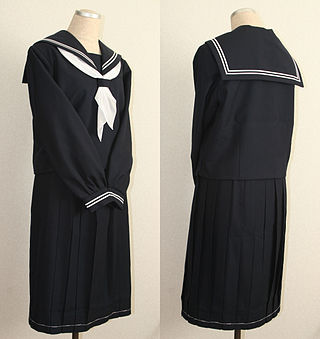
Japanese (sailor) school uniforms replicate the traditional English clothing piece that is heavily based on the British Royal Navy sailor uniform. These school uniforms were used in Japan in the late 19th century, replacing the traditional kimono. Today, school uniforms are common in many Japanese public and private schools. The Japanese word for this type of uniform is seifuku (制服).

A necktie, or simply a tie, is a piece of cloth worn for decorative purposes around the neck, resting under the shirt collar and knotted at the throat, and often draped down the chest.
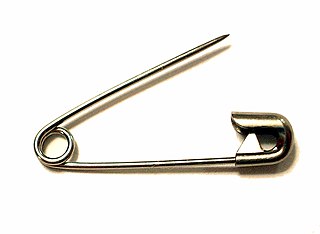
A safety pin is a variation of the regular pin which includes a simple spring mechanism and a clasp. The clasp forms a closed loop to properly fasten the pin to whatever it is applied to and covers the end of the pin to protect the user from the sharp point.

A cummerbund is a broad waist sash, usually pleated, which is often worn with single-breasted dinner jackets. The cummerbund was adopted by British military officers in colonial India, where they saw it worn by sepoys of the British Indian Army. It was adopted as an alternative to the waistcoat, and later spread to civilian use. The modern use of the cummerbund to Europeans and North Americans is as a component of the traditional black tie Western dress code.

A badge is a device or accessory, often containing the insignia of an organization, which is presented or displayed to indicate some feat of service, a special accomplishment, a symbol of authority granted by taking an oath, a sign of legitimate employment or student status, or as a simple means of identification. They are also used in advertising, publicity, and for branding purposes.

An ascot tie or ascot is a neckband with wide pointed wings, traditionally made of pale grey patterned silk. This wide tie is usually patterned, folded over, and fastened with a tie pin or tie clip. It is usually reserved for formal wear with morning dress for daytime weddings and worn with a cutaway morning coat and striped grey formal trousers. This type of dress cravat is made of a thicker, woven type of silk similar to a modern tie and is traditionally either grey or black. A more casual form of ascot is in British English called a cravat, or sometimes as a day cravat to distinguish it from the formal ascot or dress cravat. The casual form is made from a thinner woven silk that is more comfortable when worn against the skin, often with ornate and colourful printed patterns.

A stock tie, or stock, is a style of neck wear. Originally a form of neck-cloth that was often stiffened and usually close-fitting, formerly worn by men generally, but post-nineteenth century only in use in military uniforms. Another type of stock is worn by certain clergy and consists of black silk or other fabric, that falls over the chest and is secured by a band around the neck. Equestrians wear a stock tie around the neck when dressed formally for a hunt or certain competitive events. Most equestrian competition rules require it to be white. It is mandated attire for use in dressage and the dressage phase of eventing. Use of the stock tie also is seen in show jumping and fox hunting. The stock tie continues to be in fashion for equestrians.
The United States Army in World War II used a variety of standard and non-standard dress and battle uniforms, which often changed depending upon the theater of war, climatic environment, and supply exigencies.

The Army Service Uniform (ASU) is a military uniform for wear by United States Army personnel in garrison posts and at most public functions where the Army Combat Uniform is inappropriate. As of 2021, the Army has two service uniforms for use by its personnel. The Army Green Service Uniform, announced in 2018 and authorized in 2020, is used primarily for daily use in situations where civilians wear business attire, such as office settings or official meetings.

The United States Marine Corps (USMC) prescribes several types of military uniform to distinguish its service members from other armed services, depending on the situation.

A tie pin is a neckwear-controlling device, originally worn by wealthy English gentlemen to secure the folds of their cravats.
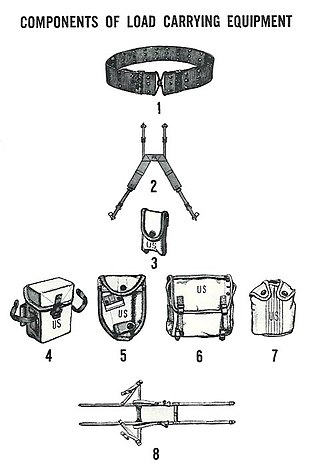
The M-1956 load-carrying equipment (LCE), also known as the individual load-carrying equipment (ILCE), was developed by the U.S. Army and first issued in the early 1960s. The M-1956 LCE was designed to replace the M-1945 Combat Pack, the M-1923 cartridge belt, the M-1936 pistol belt and the M-1937 BAR magazine belt. The M-1956 LCE was designed to be quickly configured, using no tools, to accommodate various mission and ammunition loads. The M-1956 LCE remained in service through the 1980s and set the standard for future United States military load-carrying equipment.
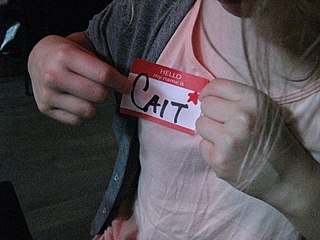
A name tag or name badge is a badge or sticker worn on the outermost clothing as a means of displaying the wearer's name for others to view.
The uniforms of the United States Army distinguish soldiers from other service members. U.S. Army uniform designs have historically been influenced by British and French military traditions, as well as contemporary U.S. civilian fashion trends. The two primary uniforms of the modern U.S. Army are the Army Combat Uniform, used in operational environments, and the Army Green Service Uniform, worn during everyday professional wear and during formal and ceremonial occasions that do not warrant the wear of the more formal blue service uniform.
Hairstyling tools may include hair irons, hair dryers, hairbrushes, hair rollers, diffusers and various types of scissors.
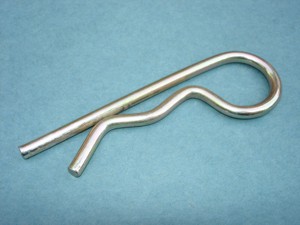
An R-clip, also known as an R-pin, R-key, hairpin cotter pin, hairpin cotter, bridge pin, hitch pin clip or spring cotter pin, is a fastener made of a durable but flexible material, commonly hardened metal wire, resembling the shape of the letter "R".

A soldier is a Salvationist who is at least 14 years of age and has, with the approval of The Salvation Army Pastoral Care Council in each local Salvation Army corps, been enrolled as a warrior in the Christian denomination called The Salvation Army – after signing the Soldier's Covenant. The soldier expresses his or her commitment in every area of life, but more specifically through the ministry and work of a local Salvation Army corps.

A master link or quick-release link is a roller chain accessory that allows convenient connection and disconnection of a chain without the need for a chain tool. It acts as a set of the chain's outer plates, so joining two sets of the chain's inner plate ends. Such master links may or may not be re-usable. A chain tool is nonetheless needed to adjust a chain's length, for example to shorten a new chain before connecting its ends. They are used on bicycles and motorcycles.





















